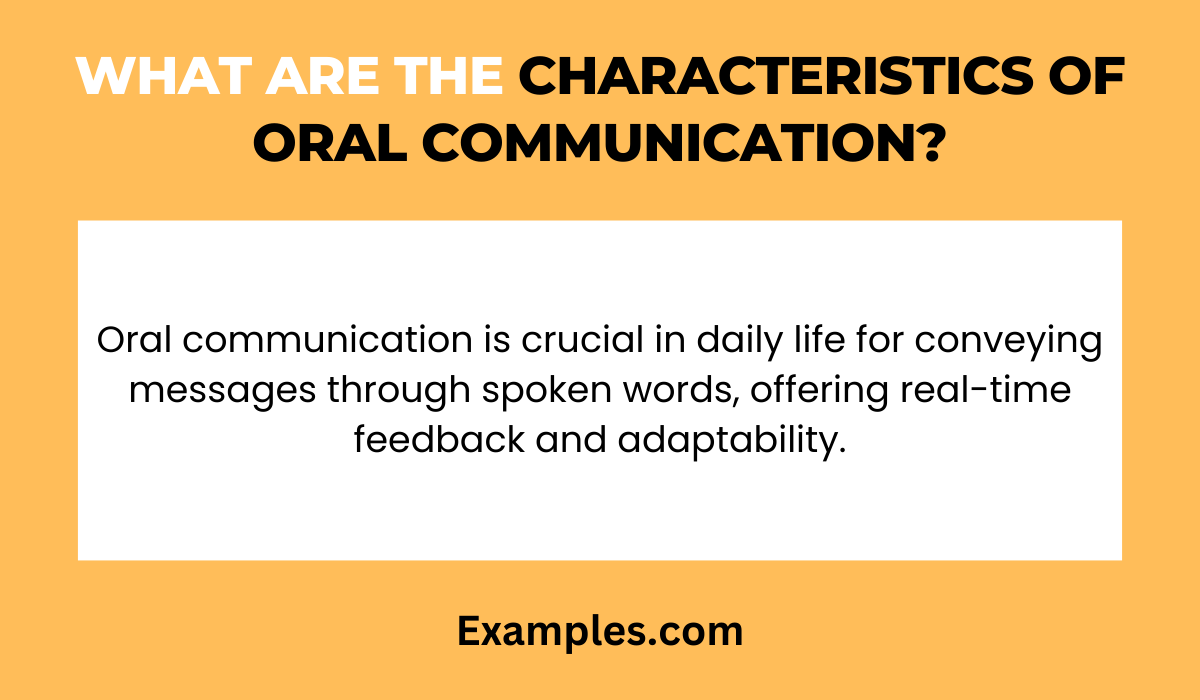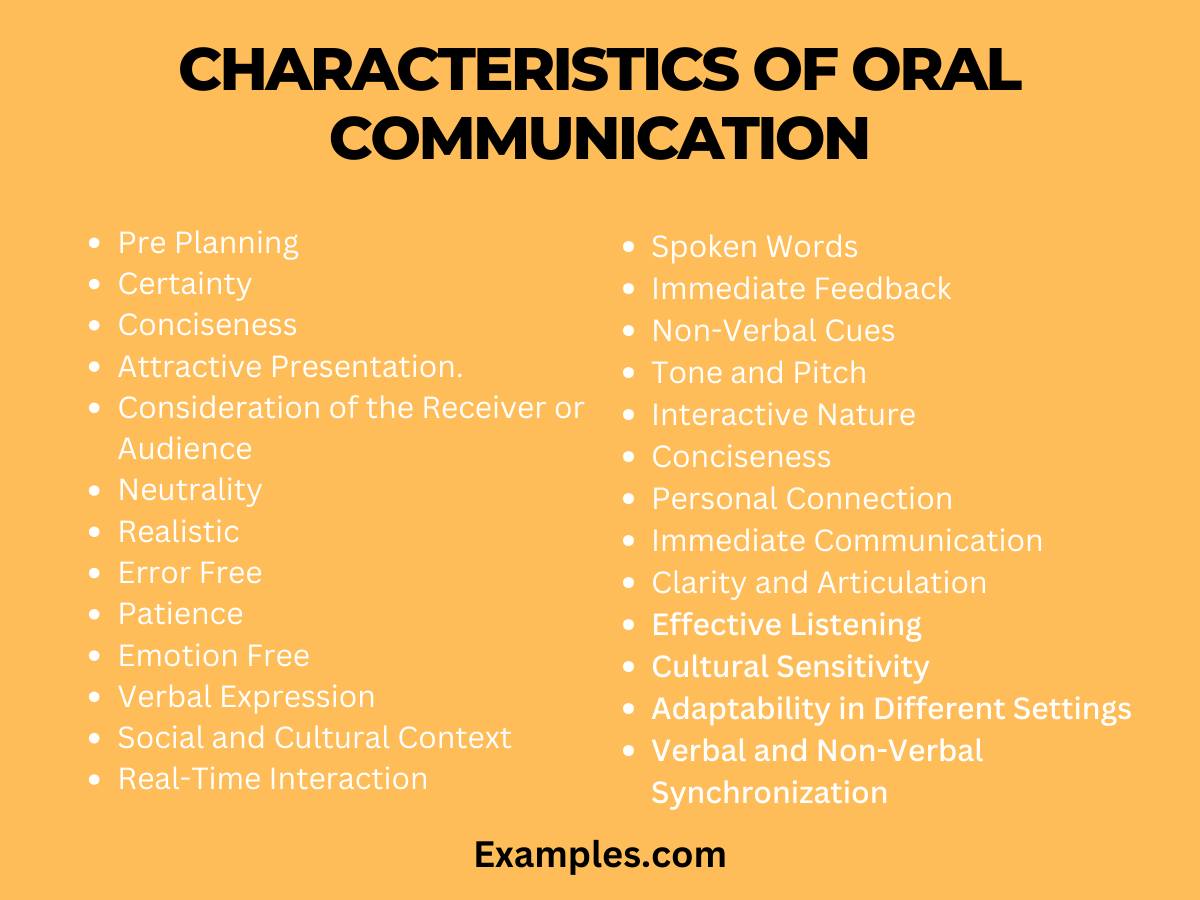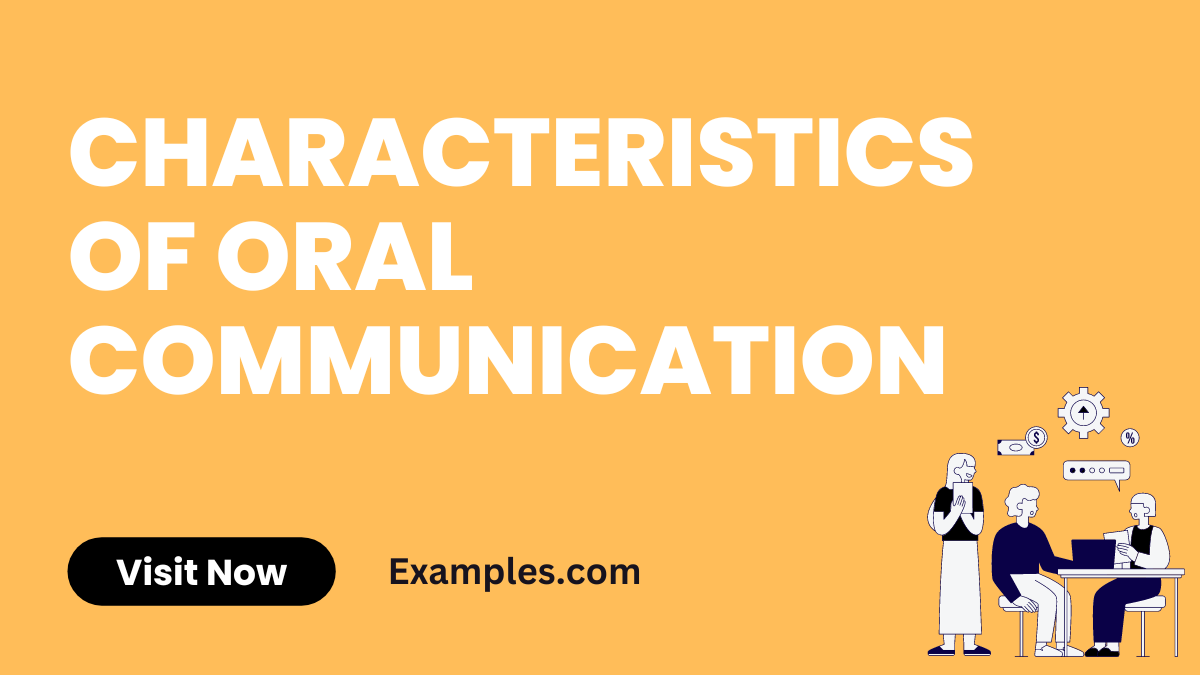14+ Characteristics of Oral Communication Examples
Oral communication is an integral part of our daily interactions, encompassing a range of skills and attributes essential for effective exchange of ideas. This guide delves into the various facets of oral communication, providing insightful communication examples to illustrate each point. We explore the spontaneous nature of verbal exchanges, where ideas flow in real-time, often leading to immediate feedback and adjustment. Understanding this dynamic can significantly enhance interpersonal relationships and professional collaborations. Additionally, we examine the role of non-verbal cues, such as gestures and facial expressions, which complement and sometimes even overpower spoken words. Effective oral communicators are adept at interpreting these signals, ensuring their message is conveyed and received as intended. Through practical examples, this guide offers a deeper understanding of these characteristics, empowering you to communicate more effectively in various settings.
What are the Characteristics of Oral Communication? – Definition

Oral communication is a vital form of interaction in daily life, especially in various professional, educational, and personal scenarios. It involves conveying messages, ideas, or feelings through spoken words. Unlike written communication, oral communication offers immediacy and flexibility, allowing for real-time feedback and adjustment of the message. The characteristics of oral communication are multifaceted, encompassing aspects like clarity, tone, empathy, and adaptability, which play a crucial role in effective information exchange and understanding.
15 Characteristics of Oral Communication

Oral communication refers to the process of conveying messages or information through spoken language. It’s a fundamental method of human interaction that occurs in various settings, from casual conversations to formal presentations. This type of communication is characterized by its immediacy, the use of tone and body language, and the potential for instant feedback.
-
Directness:

Oral communication is often direct, fostering a clear and straightforward exchange of ideas.In oral communication, directness is key, ensuring a straightforward and clear exchange of ideas. This characteristic allows speakers to articulate their thoughts and intentions without ambiguity, leading to more efficient and effective conversations. Direct communication minimizes misunderstandings, fosters transparency, and helps in building trust between parties. It’s particularly important in settings where clear instructions or immediate decisions are necessary, such as in business meetings or emergency situations.
Example: In a crisis management meeting, a team leader clearly states the steps to handle the situation, leaving no room for ambiguity. This direct approach ensures everyone understands their roles and actions to be taken immediately.
-
Personal Interaction:

It involves personal contact, promoting better understanding and relationship building.Oral communication thrives on personal interaction, which enhances understanding and relationship building. This face-to-face engagement allows for a deeper connection, often missing in written communication. Personal interactions encourage empathy and rapport, making it easier to navigate complex discussions or negotiations. This characteristic is fundamental in settings like counseling sessions or team-building activities, where personal connection and trust are crucial.
Example: A doctor conversing with a patient uses empathetic language and maintains eye contact, creating a trustful and comforting atmosphere, leading to better patient cooperation and understanding of the treatment plan.
-
Pre Planning:

Pre Planning involves organizing thoughts and information before communication. It’s essential for clear and effective communication. For instance, a teacher outlines key points before delivering a lecture, ensuring a logical flow and covering all necessary topics.
Example: A project manager creating an agenda for a team meeting, outlining key discussion points, objectives, and expected outcomes to ensure the meeting is focused and productive.
-
Certainty:

Certainty in communication means being confident and sure of what you’re saying. For example, a manager confidently explaining a new policy to employees, leaving no room for ambiguity or confusion.
Example: A doctor confidently explaining a diagnosis to a patient, using clear terms and ensuring the patient understands the treatment plan without ambiguity.
-
Conciseness:

Conciseness is about being brief yet comprehensive. It avoids unnecessary details. For example, a student writing an essay sticks to the topic, providing relevant information without digressing.
Example: An executive summarizing a lengthy report into a few bullet points for a quick executive briefing, focusing on the main findings and recommendations.
-
Attractive Presentation:

This refers to making the communication appealing and engaging. For instance, a marketer uses vibrant graphics and compelling language in an advertisement to grab attention.
Example: A web designer using visually appealing graphics and easy-to-navigate layouts to make a website engaging and user-friendly.
-
Consideration of the Receiver or Audience:

This involves tailoring the message to suit the audience. For example, a novelist uses simple language and examples when writing a book for children, as opposed to complex vocabulary for adults.
Example: A teacher adapting their teaching methods and materials for students with different learning abilities, ensuring that all students can understand and engage with the lesson.
-
Neutrality:

Neutrality in communication implies being unbiased and objective. For example, a journalist reports news without letting personal opinions influence the content.
Example: A mediator in a dispute remaining impartial, listening to both sides without taking a stand, and facilitating a fair discussion.
-
Realistic:

Being realistic means conveying messages that are practical and achievable. For example, a career counselor sets attainable goals for students, rather than unachievable ideals.
Example: A fitness coach setting achievable health and fitness goals for a client, considering their current fitness level and lifestyle.
-
Error Free:

Error-free communication is free from grammatical, spelling, or factual errors. For instance, an editor meticulously checks an article before publishing to ensure accuracy.
Example: An author proofreading their manuscript carefully to eliminate any spelling, grammar, or factual errors before publication.
-
Patience:

Patience in communication means being tolerant and understanding, allowing time for the message to be processed. For example, a teacher patiently explains a concept several times until all students understand.
Example: A customer service representative calmly dealing with an upset customer, listening to their concerns without interruption, and providing thoughtful solutions.
-
Emotion Free:

This involves keeping personal feelings separate from the message. For example, a judge delivering a verdict based on facts and laws, rather than personal emotions.
Example: A financial analyst presenting a report based solely on data and analysis, without letting personal opinions about the market influence the findings.
-
Verbal Expression:

Verbal expression is the use of words and tone to convey a message. For example, a public speaker using a confident tone and clear language to engage the audience.
Example: A politician delivering a speech with clear articulation and an engaging tone to convey their message effectively to the audience.
-
Social and Cultural Context:

This refers to understanding and respecting the social and cultural backgrounds of the audience. For example, a diplomat uses appropriate greetings and phrases when communicating in different cultural settings.
Example: An international businessperson adapting their communication style in different countries, being mindful of local customs, language, and etiquette.
-
Real-Time Interaction:

Real-time interaction is immediate communication, like face-to-face conversations or phone calls. For example, a customer service representative addressing a client’s concerns over a phone call, providing instant feedback and solutions.
Example: An international businessperson adapting their communication style in different countries, being mindful of local customs, language, and etiquette.
Oral communication stands out for its dynamic and interactive nature, making it a key aspect of effective personal and professional interactions. These characteristics highlight the importance of not only what is said, but how it is said, making oral communication a complex and nuanced form of human interaction.
Oral communication, with its dynamic interplay of verbal and non-verbal cues, plays a pivotal role in our daily interactions, significantly influencing our personal and professional relationships. The spontaneity and real-time nature of oral exchanges demand not only a clear and concise delivery of messages but also an empathetic understanding and adaptability to the listener’s responses. This multifaceted skill set, which includes clarity, tone, empathy, and adaptability, is crucial for effective information exchange and understanding in various contexts, from professional settings to personal conversations.
To further explore these concepts, the following external resources may provide valuable insights of Harvard University’s Program on Negotiation, which offers detailed articles and guidance on effective communication strategies in professional settings, including negotiation and conflict resolution.



